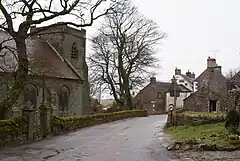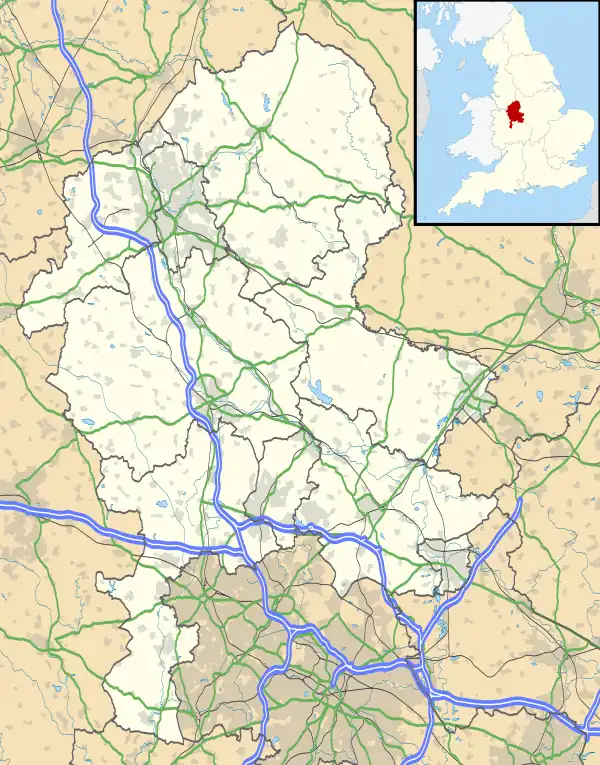| Flash | |
|---|---|
 | |
 Flash Location within Staffordshire | |
| OS grid reference | SK024671 |
| • London | 171 mi (275 km) |
| District | |
| Shire county | |
| Region | |
| Country | England |
| Sovereign state | United Kingdom |
| Post town | BUXTON |
| Postcode district | SK17 |
| Dialling code | 01298 |
| Police | Staffordshire |
| Fire | Staffordshire |
| Ambulance | West Midlands |
| UK Parliament | |
Flash is a village in the Staffordshire Moorlands, England, and Peak District National Park. At 1,519 feet (463 m) above sea level, it is the highest village in the United Kingdom and was an early centre for Wesleyanism.
Location and geography
Flash is the main village in Quarnford parish. It lies just off the A53 main road about 4 miles (6.4 km) southwest of Buxton. It is on the southern slope of the highest ground on Axe Edge Moor, which rises to a peak of 551 m (1,808 ft).[1] The parish forms the Staffordshire corner of Three Shire Heads, a tripoint marked by a packhorse bridge on the River Dane, where Staffordshire, Derbyshire and Cheshire meet.
To the south is Morridge, with a trig point at 489 m (1,604 ft)[1] at Merryton Low which provides views across the Cheshire Plain and The Roaches, including Ramshaw Rocks and Hen Cloud. The Winking Man is a rock outcrop on Ramshaw Rocks that resembles a human face in profile; its eyehole appears to wink to passing travellers on the A53.
East of Flash, and just over the A53, are the heads of the River Dove and River Manifold. Further south is the source of the River Churnet and to the north is the source of the River Goyt.[1] The River Dane also rises within the parish.
Highest village in Britain
At 1,519 ft (463 m) above sea level, Flash claims to be the highest village in the United Kingdom.[2] In 2007 the claim was upheld by the BBC, which settled a dispute with its rival claimant, Wanlockhead in Dumfries and Galloway. The Ordnance Survey measured the highest house in each village, and the one in Flash was higher, although the results were disputed by residents of the Scottish village.[3]
The former Methodist Chapel in Flash is the highest in Britain; the certainty is helped by the scarcity of Methodist chapels in the Southern Uplands.[4]
The village
During the first half of the 19th century, the population of the parish was around 700; it had reduced to half that by the end of the 1800s. In 1851 there were 40 agricultural labourers, about the same number of silk workers, and almost as many colliers. There were also stonemasons, dressmakers, blacksmiths and cordwainers, and a shoemaker, errand boy, wheelwright, game-keeper, grocer, peddler and tailor, as well as a number of house servants, 275 young people and 50 scholars. At one time 29 families were receiving weekly relief and 23 families occasional relief, nearly a quarter of the population.
The first record of coalmining in the parish comes from 1401 when Thomas Smith took a year's lease on the 'vein coal' of Black Brook, near Upper Hulme. There were a large number of coal pits in the area, including Orchard Common, Blackclough, Hope, Goldsitch and Knotbury. They were worked throughout the 18th and 19th centuries, and some into the early 20th century, for both commercial and domestic use.
Flash is an isolated community with a small population; it previously had a school attended by as few as four pupils (the school is now closed). Flash previously had a reputation for being a centre for illegal activities such as cock fighting and counterfeiting ('Flash money').[5] According to some sources,[6] the counterfeit money manufactured at Flash used to be exchanged at the nearby Three Shire Heads (where Staffordshire, Cheshire and Derbyshire meet, and where prizefighting was also said to have taken place.[7] The village currently has a village shop, Flash Bar Stores, and a brewery, Flash Brewery,[8] which produces bottled beer suitable for vegans.[9]
St Paul's is the parish church of Quarnford, in the middle of Flash village. The church was rebuilt in 1901 to the design by Buxton architect William Radford Bryden and is a Grade II listed building.[10]
Methodist history
Wesleyan Methodism was so well established in Flash during the 18th century that a chapel was built as early as 1784. At this time, there were 61 Methodist "members of Society".[11] This account suggests that Flash became a centre from which Methodism spread into other neighbouring villages, such as Hollinsclough.[12]
See also
Notes and references
- 1 2 3 Buxton & Matlock (inc. Chesterfield, Bakewell & Dove Dale (Map). 1:50000. Landranger. Ordnance Survey. § 119.
- ↑ Keane, Phoebe (17 April 2019). "Where is Scotland's highest village?". BBC News. Retrieved 17 April 2019.
- ↑ "Highest village claims were no Flash in the pan". Macclesfield Express. 15 August 2007. Archived from the original on 15 July 2014. Retrieved 26 January 2012.
- ↑ This was the subject of debate in The Methodist Recorder in the late 20th century. A letter from Rev. R O Higginson, whose work as a Methodist minister had included Flash, settled the matter.
- ↑ Flash village history booklet available in Parish Church
- ↑ "for example". Archived from the original on 3 March 2016. Retrieved 15 May 2006.
- ↑ "Flash". Peak District Guide. Archived from the original on 14 April 2016. Retrieved 4 September 2017.
- ↑ "Flash Brewery - beers from the dark worlds..." Flash Brewery. Retrieved 4 September 2017.
- ↑ "Product page". Flash Brewery. Retrieved 4 September 2017.
- ↑ Historic England. "CHURCH OF ST PAUL (1374564)". National Heritage List for England. Retrieved 4 October 2020.
- ↑ J B Dyson, "Wesleyan Methodism in the Leek Circuit", 1853
- ↑ Dyson, op cit records the conversion of John Lomas who later built Holinsclough Chapel